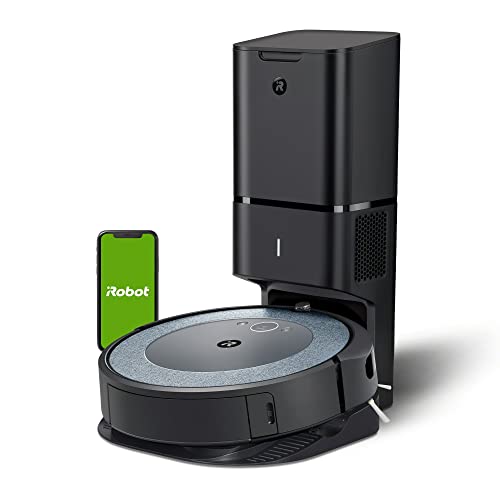The Convenience of a Self Emptying Robot Vacuum
A robot vacuum that self-empties stores debris in a large storage bin that is located inside its docking station, rather than releasing them into the air. This could be a big issue for those with allergies.
If you live in a big home, you should consider models that has a long runtime as well as a big dustbin that can return to its base to recharge between cleaning sessions. It is also advisable to consider apps that let you set no-go zones and alter settings such as suction power.
1. Less Ill
One of the biggest disadvantages of standard robotic vacs is that they typically have tiny dustbins that need manual emptying after each few cleaning sessions. This can be a problem, especially if someone in your household suffers from allergies The process of emptying the dustbin can result in a haze of noxious debris being kicked up into the air. This issue can be solved with self-emptying robots that automatically empty their collection canisters into a larger container. This brings the glorious vision of a completely automated household a little closer to reality.
Generally, self-emptying robots have an exclusive dock that not only charges the device but is also connected to a number of vacuums which pull dirt and debris from the collection container and place it in a large bin. The robot will return to its base when the canister is full, and will empty the contents into its dock. Then it will move to a different area of the house to be cleaned. This process is less annoying than emptying the dust bin onboard and is also much easier to complete since you won't be inhaling the particles that are released into the air as it happens.
The self-emptying feature is expensive, which makes it an advantage. This is important to keep in mind when deciding on the best model for your requirements. You'll also want to make sure that the size of the canister is large enough to accommodate your desired frequency of cleaning and the size of your home.
Self-emptying robot vacuums aren't required for all people, but it could be an essential tool for allergy sufferers and busy families who wish to save time and eliminate the headache of emptying a trashcan. It's also a great choice for people who have large homes that are too difficult to cover with just a single robot vacuum without needing to constantly empty the small dust bin of the machine.
A lot of self-emptying robotics are designed to make your life easier. They include features such as app control scheduling, mapping technology, scheduling mop/vacuum switch functions and many more. They can be connected to your Wi Fi and smart home devices that allow you to control them when you are not at home.
2. Reduce the amount of waste
The tiny robots that shuffle around your home and suck up pet hair and dirt can be wonderful, but their small dustbins need emptying frequently. They can also get tangled up in stray items like stray shoelaces phones, pet chargers, and shoelaces toys, or even snagged on the thresholds of doors and thick carpets.
The solution to the small robot vac dustbin issue has been the introduction of self-emptying models. These vacs automatically return to their original location when the canister gets full and empty out all that dirt with a loud squeak into a high-height bin that holds an empty paper vacuum bag. The vacuum then goes back to the pre-programmed routine.
These models can also detect when the battery is low. They can then pause the cleaning process and return to the base to charge, then resume the cleaning when the battery is fully charged. If you're looking for even more convenience, opt for one that can be scheduled at specific times (such as every three months) to drain the vacuum.
These models are more expensive than standard robotic vacuums, but they are worth the cost in certain homes. This is particularly relevant for people suffering from respiratory or allergies. They're designed to trap more dust hair, pet hair, and other allergens than regular vacs, so they can help reduce those symptoms.
The latest robotic vacuums employ sophisticated technology to map your entire home prior to every cleaning session, which makes them much more efficient than their earlier counterparts. They can also create "no-go" zones to keep out certain areas, such as toys for children or carpets that you don't want damaged. Some allow you to schedule cleaning times each day, every week or when you're away. Some models include a voice assistant and remote control for ease of use. They are ideal for busy families who want clean and healthy living without having to spend all their time doing chores.
3. Less Time
Self-emptying robotic vacuums eliminate one of the longest steps in the process. These models automatically move debris from their onboard bins to a larger container at their base station after they detect it is full. This means that cleaning sessions to be interrupted to empty the bin and makes it easier for busy individuals to do.
To test the capacity of a self-emptying robotic system to transfer debris from its onboard dustbin to the base that it is charging, we added a weighted amount of dry debris to the robot's onboard dustbin and measured the amount that ended up in the receptacle for charging docks. In our tests, models that transferred more of dry debris to the dustbin bag that is used for charging the base or bin received a better score.
This is especially beneficial for busy families and those with mobility issues, as it eliminates the necessity to pause the cleaning process to empty and open the dustbin onboard. Some models are linked to voice assistants, such as Alexa and Google Home, so you can track the robot's progress. They also allow you to set no-go zones, observe the robot's performance, change settings and schedule cleaning sessions -- a huge help for those with a little time to spare.
It's worth noting that while a self-emptying robot is less of a time-consuming chore to perform, it is nonetheless louder than many traditional vacuums. robot vacuum that empties itself is a crucial aspect to take into consideration for those who are sensitive to noise. If you're worried about noise levels, search for a robot with a Quiet Mode or plan your cleaning sessions for when you're out of the home.

Because of these advantages, these machines tend to be less time-consuming to use than other vacuums. This allows you to use them more often, and also keep your floors clean for longer.
4. Less Money
As a convenient feature as a convenience feature, the self-emptying robot vacuum adds value and functionality to compatible models of robot vacuums. The dust bin can be messy and takes a long time to empty, and this feature makes it simpler for you to. It makes it easier to utilize a robot vacuum in larger homes in which you might need to use it more frequently.
Self-emptying robots tend to be a little more expensive than other types of robots. This is due to the fact that they have more sophisticated systems to manage and store the dirt and waste they accumulate. Some have an automatic hopper that dumps the waste collected into a bin, with the capacity usually limited to approximately 2.5-3 litres. This means you'll only need to empty it every two or three cleaning cycles, which can save a lot of mess and hassle over the life of the robot.
The most sophisticated of the self-emptying robots also can create an exact map of your home, allowing you to label your rooms and set virtual no-go zones. Some models are controlled by voice assistants, such as Alexa. The best models aren't inexpensive. They cost over $1000.
Although a robot vacuum that self-empties will save you time, it is not completely foolproof. Even the most sophisticated of robot vacuums can get stuck in furniture, on thresholds for doors or on thick rugs, and get snagged by items like cords, shoelaces and phone chargers and pet toys. If this happens, it may need a thorough floor examination before you let your robot go, or it may just give up and send an SOS to you asking for assistance.
The other drawback of the self-emptying base is that it's an enormous and heavy device, which can make it difficult for robots to squeeze under furniture or within tight spaces. It can take up plenty of space on your coffee table or kitchen counter, particularly if it has an external bin that has a capacity of up to six litres.
